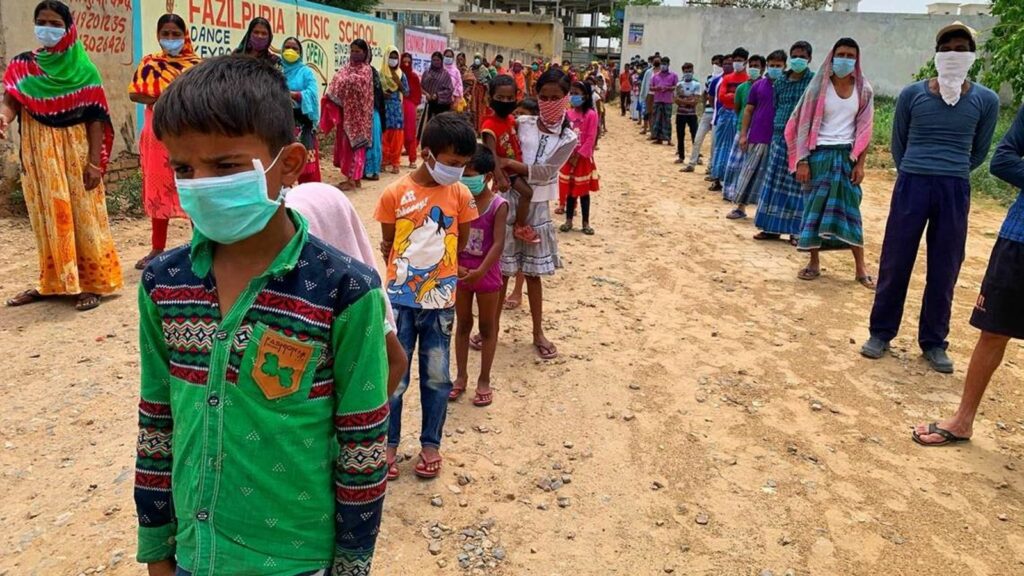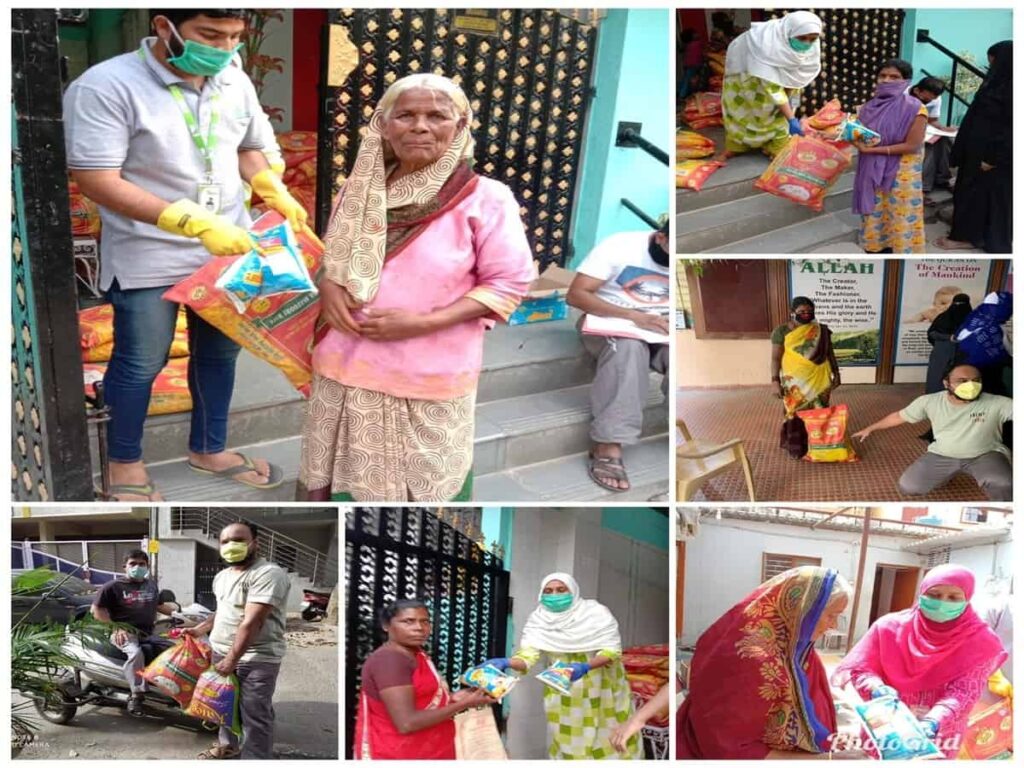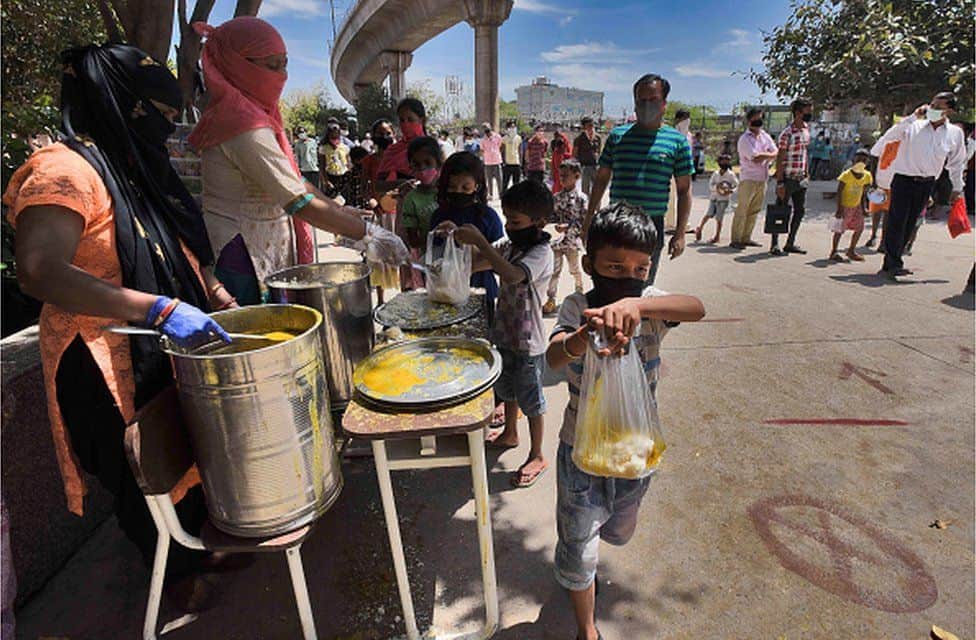2020 has been extremely challenging for people across the world. With COVID-19 cases spreading like wildfire and death tolls rising beyond prediction, the whole world came to a halt. India too has been in a similar situation for at least 9 months now.
With an exponential rise in cases despite a strict lockdown, the state of our COVID-19 response was nothing short of abhorrent. But behind the woes of COVID lie wails of hunger from people whose lives were displaced and livelihoods disrupted.
According to Google search trends data for 2020, the query ‘food shelters near me’ was searched more than ‘COVID testing centers near me’ in India.
According to the United Nations, the pandemic has severely affected global hunger and the effects are going to be seen for really long. By 2030, the number of undernourished individuals could reach as high as 909 million, significantly higher than pre-COVID predictions.
The most affected in India were the migrant workers who lost their means of income and had to travel cross country to reach their homes. Those who got stuck in a different state due to lockdown suffered too. With no proper mechanism in place from the central government, state governments had to take it upon themselves to tackle the issue of hunger. However, it wasn’t sufficient to solve a crisis that is a result of massive structural inequalities in Indian society.
In this article, we take a closer look at the conditions that led to the hunger crisis and food insecurity in India and how the COVID-19 pandemic worsened it.
Background:
In order to understand the conditions leading up to the current crisis, we must first take a look at the Public Distribution System (PDS), which is the center of the Indian Government’s response to tackling food insecurity. PDS was established after the Second World War and emerged to be the largest universal distribution system in the world.
The prime focus of the program was to increase agriculture production domestically and contribute to food security. Through an association of central and state governments, the food safety net program aims to provide essential supplies including wheat, rice, sugar, and oil. The program doesn’t give out all the necessary products for a household but only provides goods that could supplement the already procured or farmed goods.
The Food Corporation of India (FCI) is the nodal organization liable for the acquirement of food grains from farmers at a higher value than the market price. The individual state governments at that point get the food grains at a sponsored cost known as the ‘central issue price’ from the FCI; these products are then dispersed to the public by means of ration and fair price shops.
PDS has been amended and restructured multiple times ever since. In 1992, it was reorganized to extend coverage to people in remote areas. Further restructuring happened in 1997 in the form of TPDS (Targeted Public Distribution System) to target lower socio-economic areas. Then came the Antyodaya Anna Yojana that ensured the distribution of grains and highly subsidized food to marginalized groups. Senior citizens and pensioners were also included.
The major strengthening of PDS happened via the National Food Security Act (NFSA) of 2011 and included nourishment of lactating mothers, women, and children via Integrated Child Development Services and Mid-Day Meal Schemes. Thus, PDS sought to cover 75% of the rural population and around 50% of the urban population.
But how much of this is being successfully implemented?
In the 2019 Global Hunger Index, India was ranked at 94 out of 107 nations, below our neighbouring countries Bangladesh, Pakistan, and Nepal.
The state of hunger in India was termed as “serious” based on indicators like “proportion of the undernourished population, stunted growth in children, and child mortality rate.”
Research suggests PDS is plagued with widespread corruption, improper coverage, low quality of food, and many more structural challenges.
Experts have noted that there is no proper system in place to measure feedback concerning discrepancies in dispersion at fair price shops. Other reported issues are ghost ration cards or duplicate cards, massive food wastage, black marketing, diversion of supply, improper categorizing of Above Poverty Line (APL) and Below Poverty Line (BPL) households.
Adding to this myriad of problems, food security in India took further blow due to the lockdown imposed to combat the COVID-19 pandemic.

Food Crisis During Lockdown:
COVID 19 pandemic led to new forecasts of food insecurity for several countries across the world. Even the relatively stable countries have been facing debilitating conditions with respect to hunger.
At the same time, it has been reported that there is a massive food surplus. It only goes to show that the pandemic managed to lay bare the inequalities among people all over the world. These inequalities are further significant at the intersections of gender, caste, class, and race.
A nationwide lockdown was announced in India on 24 March 2020 to combat the spread of COVID-19. The lockdown, however, turned into a large scale emergency. By the time of the announcement of the nationwide lockdown, several state government’s started declaring their own lockdown plans.
The nationwide lockdown was initially considered a short but strict affair but the severity of the outbreak managed to stretch it for months. Non-essential services were all shut down. As a result, the most affected people were the low-paid staff and daily wage labourers.
Many families were left with no source of income or livelihood. Even the families who were financially secure ended up taking a hit due to loss of employment. Several surveys started to point towards an imminent crisis due to hunger and starvation.
Migrant workers were stranded away from their home states for months with no income or support. Many started going back to their homes by foot as the strict lockdown resulted in the ban on all public transport. 32 days into the lockdown, the Stranded workers’ action network found that many of the migrant workers were starving and had no money left with them.

In Hyderabad, the most affected were the construction workers who were stranded in the city with no work as construction activities did not begin until August. Many laborers from the northern part of the country left the city after a long struggle via Shramik express but haven’t returned even as the construction work has begun.
It was difficult for these people to avail benefits of Public Distribution System (PDS) as NSFA rules that welfare can be availed by identified beneficiaries in their home states only.
State Response
The Centre For Policy Research analyzed the state responses to tackling this crisis. They have found that many state governments made efforts to expand the beneficiaries of PDS to include migrant laborers and other low-income households. Although the Central government announced its measures for expansion they were still very exclusionary,
States had to act quickly and swiftly in order to address the crisis. Delhi, Madhya Pradesh, Kerala managed to identify people in need and provided them with ration. Delhi government’s work is particularly praiseworthy as they did not make use of identification for the distribution of ration and let people self certify.
Madhya Pradesh let the districts decide the beneficiaries. Bihar went with the reports of Self Help Groups (SHG) and implemented the ‘Jeevika’ program to help the vulnerable.
Apart from the ration, several states distributed cooked meals. In Kerala, community kitchens were organized to provide people with freshly cooked meals.
The Delhi government turned its school buildings into hunger relief centers. Many states established relief centers and food shelters for people, with a major focus on urban areas.
In Hyderabad, Annapurna Canteens by the Greater Hyderabad Municipal Corporation served as the saviour for several stranded construction labourers.
Citizen Response
There have been many instances where Citizens and Non-governmental organizations actively took part in contributing to tackle the crisis. One of the most recognized efforts was #FoodForNeedy in Bangalore started by food blogger Naveen Suresh that went on to feed thousands of people in the city of Bangalore.
Hyderabad saw several individuals distributing ration and cooked meals all across the city. Long lines of food distribution were seen everywhere with food packets, water being given out. NGOs based in the city worked hard to provide ration and meals to people in need.

All across India, Citizen-led initiatives for food distribution gained momentum. NGOs also worked in collaboration with governments to ensure that the food reached the people in need.
Damages
The state and citizen response tried to minimize the crisis but these efforts took time to be implemented and were limited to only a few states and cities. The existing problems in PDS worsened during this time.
People were left to look for means to fend for themselves. Reports suggested that many people died by suicide triggered by economic conditions and fear of starvation.

There have been a number of reports of migrant worker deaths due to hunger. According to a report by Violence lab, hunger and distress led to the deaths of at least 752 people by the end of May.
Railway officials confirmed that the Shramik express trains that began on May 1 have reported 80 deaths until May 30. In a gut-wrenching incident, 16 workers resting on railway tracks in Aurangabad lost their lives as a goods train ran over them.
The Union Ministry of Labour and Employment, however, said that they have no data related to migrant worker deaths. Such is the abysmal state of our governance.
Throughout the lockdown period, the news cycle in major news channels was dominated by ugly spats between celebrities and conspiracies in light of the death of actor Sushant Singh Rajput. It is common knowledge that several media houses received instructions to report only positive news related to the pandemic and lockdown. Indian state’s failure to address hunger and starvation never received media attention. The widely talked about PM Cares Fund and its utilization still remains a mystery.
Meanwhile, the National Family and Health Survey data proves that despite recording economic growth in the last three decades, India failed to solve the issues of hunger and food insecurity. Added to this was the sheer negligence to this issue during the lockdown that pushed the vulnerable population of this country further into distress.
As this year comes to an end, all the lives lost to COVID-19 will be remembered and mourned. But the unheard cries of hunger and starvation behind it may not even be registered in the public consciousness. After all, the government has no “data” on it.

